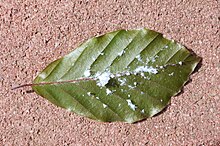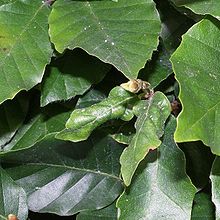Beech aphid
| Beech aphid | ||||||||||||
|---|---|---|---|---|---|---|---|---|---|---|---|---|

Winged specimen with only moderately developed wax wool |
||||||||||||
| Systematics | ||||||||||||
|
||||||||||||
| Scientific name | ||||||||||||
| Phyllaphis fagi | ||||||||||||
| Linnaeus , 1767 |
The Buchenblattlaus ( Phyllaphis fagi ), also called Woolly Buchenlaus , Buchenzierlaus , Buchenblattbaumlaus or Buchenwolllaus referred to is a aphid from the genus Phyllaphis in the family of ornamental aphids (Callaphididae). A striking feature of the beech aphid are white excretions of wax wool that adhere to the animals.
features
The lice reach a body length of one to three millimeters and are light green, some animals show differently pronounced dark banding of the abdomen . Winged divorce as well as wingless animals to be back pores white regressed back tubes to bluish white wax threads of which give them a woolly appearance.
Way of life



The host plants of the beech aphid are beech species , in Europe in particular the common beech and its varieties such as copper beech and Süntel beech , in North America the American beech and in Turkey the oriental beech . The animals rarely settle on subordinate plants such as the forest lady fern . In contrast to many other aphids, the beech aphid does not change host ; Even winged generations do not seek any other host plant species.
The holocyclic generation sequence begins in spring with the hatching of the larvae from the winter eggs, which were laid on the buds and crevices of the host plant in the previous year. The animals, initially 1 mm in size, seek out budding buds to eat, where they develop - depending on the weather conditions - after about two to three weeks and at least three moults into winged, 2-3 mm large fundatrices (Latin : Fundatrix : parent mother). One to two days after the last moult (end of May) they begin with the birth of young larvae of the next generation ( virgines ). A fundatrix can produce up to 80 virgines.
The first generation of virgines form colonies on the underside of infected leaves. Several generations appear during the summer, with both winged and wingless adults developing , which produce further generations through asexual reproduction by autumn . Only in autumn does a gender generation appear with winged males. After mating, the females lay 10 to 16 winter eggs on the host plant.
Like all aphids feeds Phyllaphis fagi mainly by amino acids from the vascular bundles of the host plant, they with the suction pipe formed mouthparts pierces. Most of this phloem sap , which is rich in carbohydrates , is excreted as sugary honeydew .
distribution
The distribution area extends over large parts of warm temperate Europe to the Caucasus . In Asia there are also deposits in Anatolia . The species is also found in North America, Australia and New Zealand.
meaning
Leaves and shoots of the host plant can be so severely damaged in the event of severe infestation that the infested leaves curl up from the edges and often dry out from the edges, turning brown. Completely withered shoot tips are also part of the damage. While such damage is usually negligible in larger trees, it can cause significant loss of growth in young crops and hedges.
The beech aphid is an important producer of honeydew in terms of beekeeping. Among the predators are hoverflies , parasitic wasps , lacewings and ladybugs .
supporting documents
Individual evidence
- ↑ a b J. Zahradnik: Der Kosmos-Insektenführer , p. 126. Franckh'sche Verlagshandlung Stuttgart, 1989. ISBN 3-440-05989-8
- ↑ Hasan Çanakçioglu: About the occurrence of aphid species (Aphidoidea) in the Turkish forest . Pest indicator, pp. 152–154. Issue 45, 10. 1972 doi : 10.1007 / BF01879317 /
- ^ Heinrich Schmutterer: To the knowledge of the beech aphid Phyllaphis fagi (L.) (Homoptera, Aphidoidea), an important honeydew producer on beech. Journal of Pest Science, Vol. 25, 1. 1952. doi : 10.1007 / BF02276343
literature
- P. Burschel and P Vité: New observations on the beech aphid Phyllaphis fagi L. (Hem., Aphididae) . Forstwissenschaftliches Centralblatt, pp. 181–186. Issue 70, No. 3. 1951. doi : 10.1007 / BF01826047
- Adolf Brauns: Taschenbuch der Waldinsekten , pp. 118–119, 122. 4th edition. Gustav Fischer pocket books, Stuttgart, 1991. ISBN 3-437-30613-8
Web links
- Brief description of the species - Phyllaphis fagi (L.) Woolly beech louse ( Memento from July 4, 2008 in the Internet Archive )

